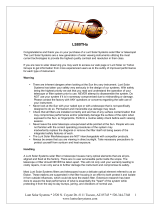Page is loading ...

1
Manual
DSII Module with “Pressure Tuner” for LS80TH
α
-Telescopes
Congratulations and thank you on your purchase of a Lunt Solar Systems instrument! The Lunt Solar Systems
are a new generation of solar viewing instruments utilizing the most current technologies to provide the highest
quality contrast and resolution in their class.
Warning
There are inherent dangers when looking at the Sun thru any instrument. Please note the safety instructions in
the manual of your LS80THa telescope.
Handling and Cleaning
Please also note the relevant instructions in the manual of your LS80THa telescope. These also apply to the
DSII module.
The DSII Module with “Pressure Tuner” for LS80TH
α
Telescopes
The DSII module is an upgrade to the standard LS80THa solar telescope. The DSII module contains a specially
designed re-collimating and refocus lens set that will only work in the LS80THa. The module contains a precisely
tuned narrowband interference filter in a sealed cavity. This filter will reduce the bandwidth of the LS80THa to
<0.5 Angstroms. The DSII system utilizes our advanced “Pressure Tuner” technology, allowing for easy tuning of
the finest details.
The DSII module is designed to provide enhanced surface detail, allowing for higher contrast views of the
filaments and active regions. Some dimming of the prominence (edge) details will be noted due to the narrowing
of the bandwidth.
Attention: Because the DSII module was designed ONLY for use in LS80THa telescopes, and in these
telescopes all necessary energy filters are already installed, the DSII module has no extra energy filters.
Therefore never use the DSII module without a LS80THa telescope! IR and UV radiation can damage your
eyes when the DSII module is used without LS80THa telescope!
What is delivered with the system?
- DSII module for LS80THa telescopes
- Internal Etalon with “Pressure Tuner”
- 6 thumbscrews for easy installation and removal
- Shipping box with die cut foam insert
- Instruction manual
Okay let's get started...
Safety First!
- Always check any solar telescope before use. Do not use any telescope or filter that appears to be
damaged. Verify that all glass and filters are in place.
- The Blocking Filter diagonal or extension tube must always be used with the Lunt telescope or filter.
At first follow the instructions for your normal LS80THa telescope. If you have sharp focused the sun you would
tune the built-in H-alpha filter. Note of the position of the black handle of the Pressure-Tuner on the brass
cylinder.

2
Installing the DSII module at the telescope: Take the LS80THa back from the mount, and put it on a clean
table. At the far end of the red housing with the Pressure-Tuner, you will find 3 little allen head screws that hold
the focuser and a small extension ring. Unscrew the screws with the small hexagon wrench, which was delivered
with the telescope and remove the focuser and the extension ring.
If you have removed the focuser, unscrew the 3 allen head screws completely out and replace it with the 3 at the
DSII module delivered thumbscrews.
Now place the DSII module to the point where previously the focuser was and fix it with the just inserted 3
thumbscrews. If you unscrew the thumbscrews again you may rotate the DSII module. This allows to bring the
handle of the Pressure-Tuner in any position. Tighten the thumbscrews again. If you want to change the position
of the DSII Pressure-Tuner later, you only need to loosen the thumbscrews.
Now place the focuser and the extension ring at the end of the DSII module. Here you will find again 3 allen
screws. With those the focuser can be mounted securely at the DSII. Now the installation of the DSII module at
the LS80THa telescope is finished.
Tuning: Install the telescope now again on your mount, and point it to the sun. Move the handle of the originally
Pressure-Tuner back into the position which you have previously noticed.
Now make a reset at the Pressure-Tuner of the DSII module, like you know it from your normal Pressure-Tuner.
Then you look through the eyepiece, and turn the handle of the DSII Pressure-Tuner so far on the cylinder until
you can see the surface details of the sun at best. You can also adjust the original Pressure-Tuner some time
until the image is optimal.
The DSII system utilizes a unique optical design that works to narrow the bandwidth while also removing the
back-ghosting that would normally occur with 2 highly reflective etalons sitting in such close proximity to one
another. This ghost removal would typically be done by tilting one of the etalons with respect to the other. But
then the Etalons are tilted so much, they are often no longer optimal in the H-alpha line. The optical design of the
DSII system works that the “ghost” images are always in an area outside the normal field of view. However,
users who have low magnification eyepieces (~25mm) with a wide field of view may notice a “halo”. Increasing
the magnification or using an eyepiece with a narrower field of view will reduce this effect. While we strive to
provide perfect anti-reflection coatings at the Hydrogen-alpha line the residual reflections are reduced to 0.1%.
Therefore not all back scatter can be totally removed. Less than perfect seeing conditions will work to increase
the background haze of the system.
Because the DSII module has no extra energy filter, the sun's image is brighter than with other double-stack
systems. Therefore prominences can be observed clearly and in detail that would be very strong dimmed with
other double-stack systems.
Lunt-Solar-Systems - Exclusive European Distributor
Bresser GmbH
Gutenbergstrasse 2, D-46414 Rhede, Germany
Phone: +49 (0) 2872 – 80 740
E-Mail: [email protected]
www.bresser.de
/
